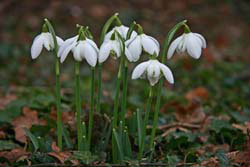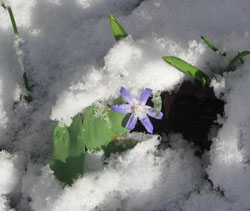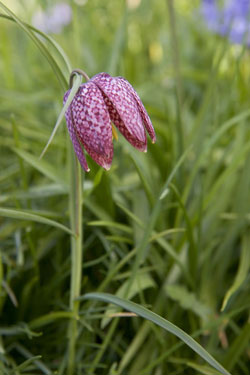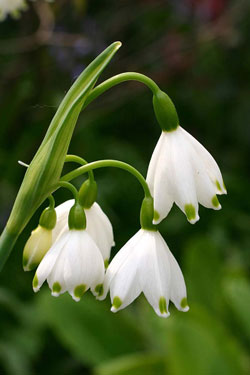Spring flowers often conjure images of tulips, crocus and hyacinths, but there are many bulbs that offer wonderful color in the spring that aren’t as common. Consider planting some of these underused beauties.

Snowdrops (Galanthus nivalis): Tiny, perfect-white flowers are bell-shaped and just peak above the ground at three inches tall. These bulbs look wonderful planted en masse and may bloom as early as February.
Glory-of-the-snow (Chinodoxa forbesii): This squill-cousin is a very early spring bloomer and may appear through snow.  Hardy with small, star-shaped flowers with white centers, this bulb reaches about six inches tall. Though blue is the most common color, glory-of-the-snow also comes in white, lavender and pink forms. As plants grow, they will naturalize areas of the garden and can be planted in lawns—just set the mower high enough to not remove foliage early in the spring.
Hardy with small, star-shaped flowers with white centers, this bulb reaches about six inches tall. Though blue is the most common color, glory-of-the-snow also comes in white, lavender and pink forms. As plants grow, they will naturalize areas of the garden and can be planted in lawns—just set the mower high enough to not remove foliage early in the spring.

Fritillary: The most common fritillary is the Crown Imperial (Fritillaria imperialis), but there are many types that come in various shapes, sizes and colors. A benefitof this plant is that it’s rarely disturbed by wildlife because of its fragrance. Fritillaries come in colors of orange, red-orange, yellow, purple-and-white checked (F. meleagris), plum and white. Smaller fritillaries do best en masse, while larger varieties can become a focal point in the spring garden.
 Snowflakes (Leucojum aestivum): Similar in look to snowdrops, but with each white petal having a small dot of green, they are taller—up to 20”.These alkaline-tolerant bulbs can bloom into March.
Snowflakes (Leucojum aestivum): Similar in look to snowdrops, but with each white petal having a small dot of green, they are taller—up to 20”.These alkaline-tolerant bulbs can bloom into March.
Allium: Becoming more common, alliums or ornamental onions, can create a statement in the landscape. With flowers that can reach several inches across, the bloom time for these bulbs can be anywhere from two to three weeks. Alliums bloom late in the spring into summer. Colors range from deep purple to white to burgundy. Height varies from as small as six up to 40 inches.
For more information, see the following Planttalk Colorado™ video(s).



